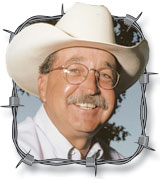There were lots of ways I justified the purchase of my last farm, some five years ago. It was only a mile from our house; it bordered one of my other places; it had a year-round spring on it that has never been known to go dry and, everyone (including my Farm Credit agent) thought I bought it below the going price of land at the time. The REAL reason, however, is simply because it reminded me of the home farm where I was raised.
It has a creek that runs along the entire southern boundary and it also has about 80 acres of very dense woods that became a lot denser after the ’07 ice storm. In my mind, I justified that it would be a wonderful place to calve out cows in the late winter, since the timbered area would provide ideal cover for the cows on cold and windy nights and I’d never have to chop ice at the place. I was right on both accounts, except I had forgotten how well cows can hide in dense woods.
Most of the time, it’s not a problem to find “calvy” cows at the new place. The majority of the time, they calve out in the open fields or, at least, just in the edges of the wooded areas. When I unroll a bale of hay for the morning feed, the newly calved cows venture out toward the feed source and their new baby will either be following close behind, or bedded down along the edge, where I can ID it and enter it into my record book. Occasionally, however, I’m not so lucky.
Four years ago, I came up a cow “short” during the morning feeding. After circling the open fields twice without finding her, I braved the cold and walked the woods for hours trying to find the old gal. By dark, I’d given up and vowed to start again the next day. I was just as unsuccessful in finding her the next day, but on the third day she walked out of the woods when I unrolled a bale of hay. It was obvious she had calved, but there was no sign of a calf anywhere. After three more days, I even entered it in the records as “dead” and had given up on ever finding it. On day ten, she finally brought it out of its hiding area and I was happy to change the record book to “healthy, red bull”.
Last month, an eerily similar event happened. Coming up one cow short on the morning rounds in late February, I bundled up for the cold winds and headed into the woods. The ice storm of three years ago had made a walk in the woods more like an obstacle course maze that has no exit. I climbed over downed trees, under partially downed trees, and through fallen branches until I felt like I’d gone at least a mile, until I looked back and still saw my truck less than a hundred yards away. I kept going… and going… and going, until I reached the clearing. Then I went a hundred feet to the east and went back. I spent the entire day searching for the missing cow, all to no avail. Ditto for the next day and the day after that. Finally, on the fourth day, I gave up, hoping that she and her calf would miraculously appear like the previous one had.
Unfortunately, after two weeks of no sightings, I began to have my doubts. Still, my curiosity (my wife calls it stubbornness) left me wanting to find out what happened.
By the middle of March, the weather had warmed and on the first day it hit 60 degrees, I decided to put my Native American heritage to work. There was a stiff southern wind blowing that afternoon, so I took the ATV and slowly drove along the entire northern boundary of the farm. Sure enough, as I came up over a hill, I caught the unmistakable smell of “something dead.” On foot, I headed directly into the wind and eventually found the cow, dead, lying up against a locust tree with a dead calf halfway outside of her. If only I could have smelled a live cow three weeks earlier, I might have been able to save both of them.
As I trekked back to the ATV, over, under, and through the woods, I remembered that this was a lot like trying to find cows in the woods of my youth. I also remembered that my father eventually bull-dozed all the woods on our farm and not just to provide more pasture and increase the carrying capacity, but so we could find cows in trouble before we had to track them by smell.
Jerry Crownover is a farmer and former professor of Agriculture Education at Missouri State University. He is a native of Baxter County, Arkansas, and an author and professional speaker. To contact Jerry call 1-866-532-1960 or visit www.ozarksfn.com and click on ‘Contact Us.’






